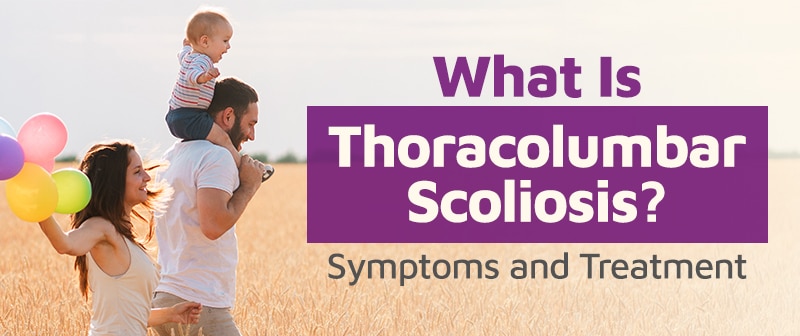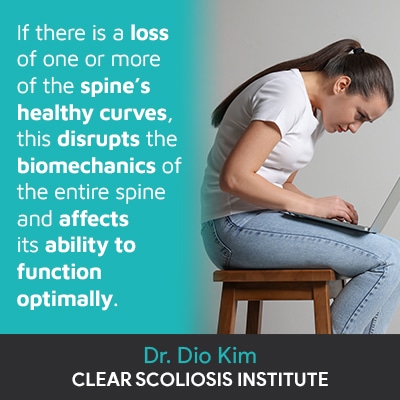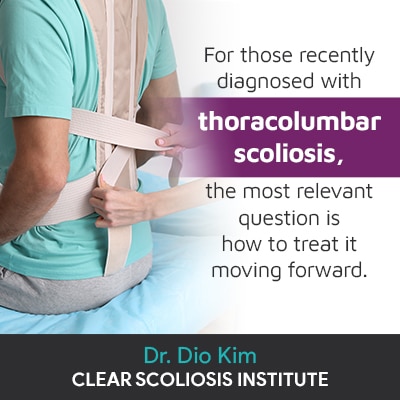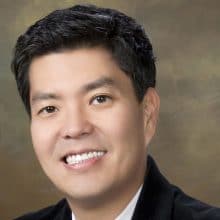
Part of the diagnostic process involves comprehensive assessment needed to further classify a condition; this streamlines the treatment process and guides the design of effective treatment plans. In a scoliosis diagnosis, patient age, causation, severity, and curvature location are key classification points.
When scoliosis is diagnosed, it’s further classified based on specific patient/condition variables: curvature location being one of them. Thoracolumbar scoliosis is a combined scoliosis that develops in the lower thoracic spine (middle back) and the upper lumbar (lower back) spine.
Let’s start our discussion of thoracolumbar scoliosis by defining the condition and the main sections of the spine.
If a person is diagnosed with scoliosis, this means they have a progressive structural spinal condition that involves the development of an unnatural sideways spinal curvature.
Progressive means that it’s in the condition’s nature to worsen over time, meaning the abnormal spinal curve will increase in size, especially if left untreated, or not treated proactively.
In addition to the unnatural sideways bend, scoliosis also involves a rotational component, meaning the spine doesn’t just bend unnaturally to the side, but also twists from front to back, back to front.
To meet the parameters of a scoliosis diagnosis, the unnatural spinal curve also has to be of a certain size, and this is determined by a measurement known as Cobb angle.
A patient’s Cobb angle is measured during X-ray and involves drawing intersecting lines from the tops and bottoms of the most-tilted vertebrae at the apex of the curve; the resulting angle is measured in degrees, tells me how far out of alignment a patient’s spine is and places the condition on its severity scale of mild, moderate, or severe.
A healthy spine will appear straight when viewed from the front and/or back, and will appear to have a soft ‘S’ shape when viewed from the sides.
The spine’s healthy curves make it stronger, more flexible, and better able to absorb and distribute mechanical stress.

So now that we have defined the condition, let’s move on to some basic spinal anatomy: the main sections of the spine.
As already discussed, the spine has natural and healthy curvatures that help keep the vertebrae (bones of the spine) aligned and their intervertebral discs healthy.
There are three main spinal sections: the cervical spine (neck), thoracic spine (middle/upper back), and lumbar spine (lower back).
Each spinal section has its own characteristic curvature type: kyphosis and lordosis.
When one section of the spine experiences a loss of its healthy curve, as the spine is one structure, it impacts the integrity of the other sections and their related curves.
Keeping the three main sections of the spine in mind, let’s move on to defining thoracolumbar scoliosis.
So now that we know the thoracic section of the spine includes the middle and upper back, and the lumbar spinal section refers to the lower back, a diagnosis of thoracolumbar scoliosis is given when a scoliotic curve develops in both sections: the lower section of the thoracic spine and the upper section of the lumbar spine.
This type of scoliotic curve that includes more than one spinal section is known as a combined scoliosis.
In most cases of thoracolumbar scoliosis, the curve bends to the right (dextroscoliosis), away from the heart, but in atypical forms, it can bend to the left (levoscoliosis), towards the heart.
While men are also diagnosed with thoracolumbar scoliosis, it’s more prevalent in women, and in terms of causation, thoracolumbar scoliosis can be idiopathic, congenital, and/or neuromuscular.
Now that we have defined the condition, let’s discuss the types of symptoms it can cause.
When it comes to thoracolumbar scoliosis symptoms to expect, every case is different; this is part of the reason scoliosis is so often described as complex.
When it comes to scoliosis symptoms, it’s important to understand that with a range of mild to moderate and severe, it is a highly variable condition, and related symptoms will depend on those key classification points mentioned earlier: patient age, causation, severity, and curvature location.
In general, the most common symptoms of scoliosis are postural changes that disrupt the body’s overall symmetry and can include the following:
Pain is another symptom of thoracolumbar scoliosis, and while scoliosis can cause related muscle pain in patients both young and old, back/radicular pain is more commonly associated with adult scoliosis.
Is Thoracolumbar Scoliosis Painful?
As mentioned earlier, there are different types of scoliosis, and while the most prevalent condition form is diagnosed as adolescent idiopathic scoliosis (AIS) between the ages of 10 and 18, it also affects adults.
The reason that back/radicular pain is more common in adults is due to growth and skeletal maturity.
In children and adolescents who are still growing, their spines are undergoing a constant lengthening motion, and this can counteract the compressive force of a scoliotic curve; as it’s compression of the spine and its surrounding ligaments, muscles, and nerves that’s known to the main cause of condition-related pain, when scoliosis becomes a compressive condition in adulthood, it can cause varying levels of back and radicular pain.
In fact, in adults, it’s radicular pain felt in the hands, legs, and feet that commonly brings them in for a diagnosis and treatment, and this pain can range from mild and intermittent to chronic and debilitating, based largely on condition severity and the degree of nerve involvement.
So to clearly answer the question, is thoracolumbar scoliosis painful, while a common thoracolumbar scoliosis symptom in adults would be back and radicular pain felt in other areas of the body, this type of pain is not as common a symptom in younger patients who have not yet reached skeletal maturity.

As a CLEAR-certified scoliosis chiropractor, I treat my scoliosis patients with a conservative and chiropractor-centered approach.
While no treatment results can ever be guaranteed, being trained and certified in a number of treatment modalities allows me to integrate different forms of treatment into the crafting of a customized treatment plan.
As mentioned earlier, scoliosis is often deemed a complex condition because no two cases are the same, necessitating fully-customized treatment plans that address important patient and condition characteristics.
Although the location of the scoliotic curve in the upper lumbar and lower thoracic spine is where I will concentrate my treatment efforts, part of the treatment protocols of the CLEAR Scoliosis Institute is to treat the entire spine to preserve its overall health and function.
As a structural spinal condition, first and foremost, I want to impact it on a structural level, and I work closely with patients to achieve this through condition-specific chiropractic care and a curvature reduction.
Through chiropractic adjustments/remodeling, we can work towards changing the position of the most-tilted vertebrae of the curve into a healthier alignment with the rest of the spine.
In addition, I use a variety of therapies known to increase core strength so the spine is optimally supported and stabilized by its surrounding muscles; these can include scoliosis-specific exercises (SSEs) that are known to help activate the brain-body connection to re-establish better body positioning.
Together, these treatment disciplines can complement one another, and throughout treatment, part of the process involves monitoring the spine for how it’s responding, and when necessary, I can apportion these disciplines differently for the most specific and customized results.
What I would really like people to understand about thoracolumbar scoliosis is that each and every case is unique and will produce its own set of symptoms, which is why customizing treatment plans, to address important patient/condition variables, is key to treatment success.
I also encourage patients, and their families, to research any and all treatment options available to them because different treatment approaches offer different potential outcomes.
As a CLEAR-certified scoliosis chiropractor, I believe patients can benefit from a conservative and chiropractic-centered treatment approach that works towards restoring as much of the spine’s healthy curves as possible while preserving its overall health and function.

CLEAR provides a unique and innovative way of understanding scoliosis. Sign up to receive facts and information you won’t find anywhere else.

I am a 65yr old black female and just read from a report that i have s-shaped thoracolumbar scoliosis. I was read to have spinal stenosis and degenerative disc disease. I have been having pain medication management since 2005 and also lately ostopenia. In the past 4-5 months, I have been having excruciating pain in my upper and lower back, where I was forced to stop working. Debilitating pain has been ravaging my body causing me sleeplessness, days and nights, weight loss and illness I cannot bear. I have been going to doctors, emergency rooms, no one can tell me why I am in so much pain with increased rapid weight loss, fatigue and other symptoms. This report is something I read in my GBMC chart, just put there two days ago. NO ONE CARES!!!!! I am suffering soooo badly. NSAP Center, Justina Mira, Nurse Practitioner, just wants to give me pills and injections in my lower back for it. I am reading here that you can help me live a better life with this diagnosis, that I can be treated for this scoliosis. PLEASE HELP ME!!!!! I am LULA M. LOWE. Please write me back. Thank you
Hello, Lula,
I am sorry to hear of the issues you have been having. I imagine it has made life very difficult for you. Pain can be from many sources. Typically someone with scoliosis notices increased pain as they age, so it is very possible the pain is a result of your scoliosis. If that is the case, our CLEAR Scoliosis Institute Doctors are certified in treating that condition. Our Doctors have treated thousands of patients of many ages and many curve sizes with great success in helping them live a better quality of life. I suggest contacting the CLEAR Scoliosis Center nearest you to determine if you would be a candidate for care. To find the nearest clinic, please visit our website under Find a Doctor. Once you find the nearest clinic and have your x-rays/MRIs sent to them, they can evaluate them and have a consultation with you to determine next steps. Best of luck to you.